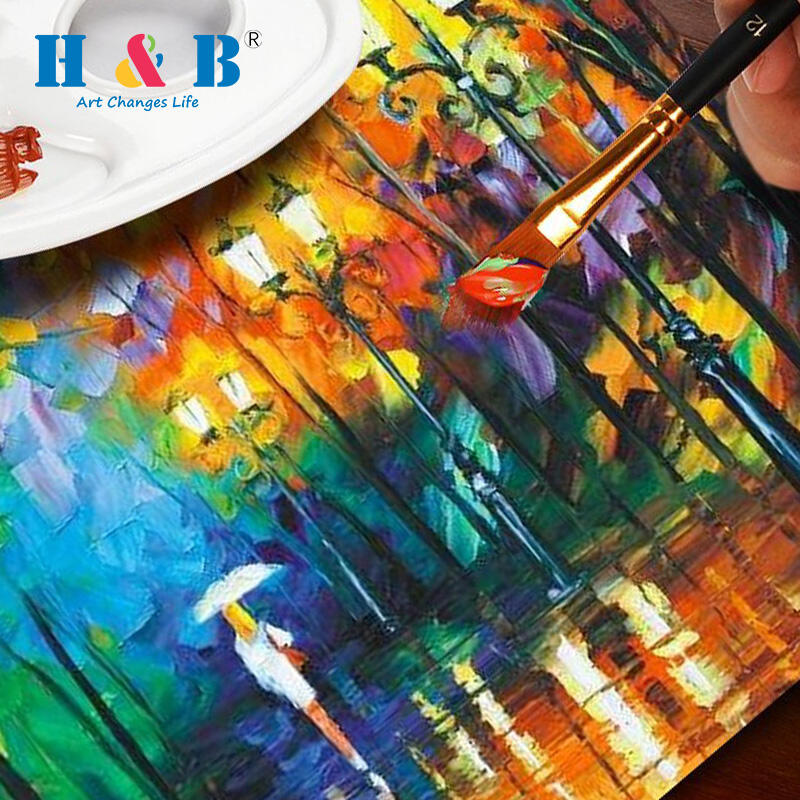The Enduring Beauty of Oil-Based Art
Artists across centuries have turned to oil paint for creating masterpieces that stand the test of time. The depth, richness, and permanence offered by this traditional medium make it a favored choice among professionals and enthusiasts alike. Whether working on canvas or wood, oil paint delivers a vivid experience unmatched by other mediums. From Renaissance classics to modern realism, the consistent use of oil paint underscores its long-standing dominance in the world of art.
Superior Color Depth and Blending
Unmatched richness in color tones
One of the standout features of oil paint is its extraordinary color depth. Unlike water-based alternatives, oil paint offers a vibrant and dimensional quality that captures attention. The high pigment concentration allows artists to achieve intense and dynamic hues, enhancing the visual impact of each artwork. This richness enables deeper emotional connections between the viewer and the piece.
Smooth transitions and layering
Oil paint’s slow-drying nature allows artists to blend and transition seamlessly from one shade to another. This feature is particularly beneficial for achieving gradients, realistic textures, and subtle tonal changes. The ability to layer oil paint without compromising the color integrity further empowers artists to construct visually compelling compositions with complex light and shadow effects.
Durability That Stands the Test of Time
Resistant to fading and deterioration
Oil paint is renowned for its durability. With proper priming and varnishing, artworks created with oil paint can last for centuries without significant degradation. Unlike other mediums that may fade over time, oil paint maintains its luster and saturation. Historical examples from hundreds of years ago continue to shine with brilliance, validating oil paint’s superior longevity.
Enhanced structural stability
The composition of oil paint contributes to its resilience. It adheres well to various surfaces such as canvas, wood, and linen, reducing the risk of peeling or cracking. When used with quality supports and sealants, oil paint creates a protective barrier that shields the artwork from environmental factors like moisture, light, and pollutants.
Flexibility and Versatility in Application
Works well on multiple surfaces
One of the key reasons oil paint remains popular is its compatibility with various painting surfaces. Whether the artist chooses stretched canvas, wood panel, or primed paper, oil paint adheres effectively and retains its brilliance. This adaptability allows artists to explore creative expressions beyond the limitations of a single surface type.
Ideal for different styles and techniques
From hyper-realism to expressive abstraction, oil paint accommodates a wide spectrum of styles. Artists can employ techniques like glazing, impasto, scumbling, or alla prima to achieve distinct effects. The medium’s flexibility makes it suitable for both meticulous detail work and bold, textured brushstrokes, enabling unique personal expression.
Extended Working Time for Detailed Work
Ample time for corrections and refinements
Oil paint dries slowly compared to acrylic or watercolor, offering a generous window for modification. This extended working time is invaluable for artists aiming for precision and detail. Adjustments can be made over several days, allowing for a thoughtful and evolving creative process.
Perfect for building complex compositions
The slower drying process of oil paint allows for building up layers gradually. This layering technique is ideal for achieving depth, dimension, and realism. Artists can step back, reflect, and rework areas without the pressure of quick drying, ultimately resulting in a more polished and refined final product.
Lustrous Finishes and Texture Possibilities
Natural sheen enhances visual appeal
Oil paint naturally dries to a rich, lustrous finish that enhances the visual appeal of the artwork. This sheen is especially noticeable in areas with heavier application, giving the piece a dynamic and polished look. Varnishes can further enhance this effect, offering protection and a professional appearance.
Texture creation adds tactile interest
Oil paint’s thickness allows for the creation of textured surfaces that engage the viewer both visually and tactilely. Techniques like impasto allow artists to build up surfaces with brush or knife, adding dimension and expressiveness to the piece. These textures catch light differently, offering a unique visual experience from various angles.
Strong Historical and Cultural Significance
Embraced by master artists
Oil paint has been the medium of choice for many of history’s greatest artists, including Leonardo da Vinci, Rembrandt, and Van Gogh. Their masterpieces, still admired today, highlight the medium’s unparalleled qualities. By choosing oil paint, modern artists connect with a lineage of artistic excellence.
Influence on art movements and education
Throughout art history, oil paint has played a crucial role in shaping artistic movements and styles. It remains a core component of fine arts education, helping students develop technical proficiency and a deeper understanding of composition, color theory, and material handling. Oil paint’s legacy continues to inspire generations of creators.
Sustainable Practice with Modern Techniques
Safer, eco-friendly options available
Modern advancements have made oil paint more sustainable. Solvent-free and low-toxicity options now exist, allowing artists to enjoy the benefits of oil paint without compromising their health or the environment. These innovations keep the medium relevant in today’s eco-conscious art world.
Minimal waste with proper handling
Oil paint can be stored for long periods without drying out, which reduces waste significantly. Artists can reuse and rework leftover paint in future projects. With mindful usage and proper cleaning practices, oil painting becomes a sustainable and efficient artistic choice.
Elevating Artistic Professionalism
Delivers a high-end finish
The professional look of oil paint gives artworks a gallery-quality appeal. Collectors and curators often favor oil paintings for their aesthetic value and perceived prestige. The richness and depth that oil paint provides can elevate even simple compositions into sophisticated pieces.
Preferred medium in the art market
Artworks created with oil paint often command higher prices in the art market due to their longevity and visual appeal. This makes oil paint not just a creative tool but also a valuable investment. For artists seeking recognition and commercial success, oil paint offers significant advantages.
Frequently Asked Questions
Why do artists still prefer oil paint despite new mediums?
Oil paint offers unmatched color depth, longer working time, and a luxurious finish that newer mediums often struggle to replicate. These qualities make it the preferred choice for serious artists.
Is oil paint safe to use for beginners?
Yes, especially with the availability of non-toxic, solvent-free options today. Beginners can start exploring oil painting safely with proper guidance and ventilation.
How long does oil paint artwork last?
With appropriate care, oil paint artworks can last for centuries. Historical pieces over 500 years old still retain their original brilliance and texture.
Can oil paint be used on surfaces other than canvas?
Absolutely. Oil paint works well on wood, primed paper, linen, and more, making it a versatile medium for various artistic expressions.
Table of Contents
- The Enduring Beauty of Oil-Based Art
- Superior Color Depth and Blending
- Durability That Stands the Test of Time
- Flexibility and Versatility in Application
- Extended Working Time for Detailed Work
- Lustrous Finishes and Texture Possibilities
- Strong Historical and Cultural Significance
- Sustainable Practice with Modern Techniques
- Elevating Artistic Professionalism
- Frequently Asked Questions


